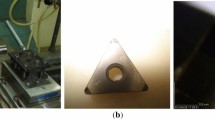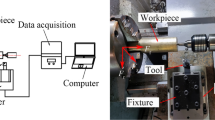Abstract
The high content of silicon of aluminum casting alloys challenges the tool life of conventional cemented carbide inserts, and polycrystalline diamond (PCD) tools appear as an interesting material to machine these alloys because they improve substantially the durability of cutting tools and consequently the productivity of machining. However, the surface roughness, cutting forces and chip morphology are equally important factors in machining evaluation. Therefore, an experimental study is performed aiming at comparing the performance of cemented carbide and PCD tools taking into account cutting forces, surface roughness and chip morphology, under dry longitudinal turning, performed for the AlSi9Cu3 alloy produced by permanent mold casting process. Different chip breaker geometries were also considered, and their influence on the referred parameters was also investigated. Analysis of variance was employed to study the different contributions of inserts, cutting speed, feed rate, depth of cut and their interactions in machinability performance. The results show low cutting forces and better results for surface roughness for uncoated cemented carbide tools, with simpler chip breakers and flat rake face PCD tool, but an efficient chip control was obtained for inserts with small grooves with high cutting forces and power consumption. Nevertheless, the feed rate and depth of cut have the highest influence on the machinability performance of the alloy under investigation.





















Similar content being viewed by others
References
T. Tanaka and T. Akasawa, Machinability of Hypereutectic Silicon-Aluminum Alloys, J. Mater. Eng. Perform., 1999, 8(4), p 463–468
G. Timelli and A. Fabrizi, The Effects of Microstructure Heterogeneities and Casting Defects on the Mechanical Properties of High-Pressure Die-Cast AlSi9Cu3(Fe) Alloys, Metall. Mater. Trans. A, 2014, 45(12), p 5486–5498
M.C. Santos, Jr., A.R. Machado, W.F. Sales, M.A.S. Barrozo, and E.O. Ezugwu, Machining of Aluminum Alloys: A Review, Int. J. Adv. Manuf. Technol., 2016, 86(9–12), p 3067–3080
P.K. Sood, R. Sehgal, and D.K. Dwivedi, Machinability Study of Stir Cast Hypoeutectic Aluminum-Silicon Alloys During Turning, J. Mater. Eng. Perform., 2013, 22(2), p 470–482
M.M. Barzani, A.A.D. Sarhan, S. Farahany, S. Ramesh, and I. Maher, Investigating the Machinability of Al-Si-Cu Cast Alloy Containing Bismuth and Antimony Using Coated Carbide Insert, Meas. J. Int. Meas. Confed., 2015, 62, p 170–178
K.G. Basavakumar, P.G. Mukunda, and M. Chakraborty, Influence of Melt Treatments and Turning Inserts on Cutting Force and Surface Integrity in Turning of Al7Si and Al7Si2.5Cu Cast Alloys, J. Mater. Sci., 2007, 42(20), p 8714–8724
H. Puga, S. Costa, J. Barbosa, S. Ribeiro, and M. Prokic, Influence of Ultrasonic Melt Treatment on Microstructure and Mechanical Properties of AlSi9Cu3 alloy, J. Mater. Process. Technol., 2011, 211(11), p 1729–1735
S. Ferraro and G. Timelli, Influence of Sludge Particles on the Tensile Properties of Die-Cast Secondary Aluminum Alloys, Metall. Mater. Trans. B, 2015, 46(2), p 1022–1034
C. Kalyan and G.L. Samuel, Cutting Mode Analysis in High Speed Finish Turning of AlMgSi Alloy Using Edge Chamfered PCD Tools, J. Mater. Process. Technol., 2015, 216, p 146–159
H.G. Kim, J.H. Sim, and H.J. Kweon, Performance evaluation of chip breaker utilizing neural network, J. Mater. Process. Technol., 2009, 209(2), p 647–656
M. Lotfi, A. Akhavan Farid, and H. Soleimanimehr, The Effect of Chip Breaker Geometry on Chip Shape, Bending Moment, and Cutting Force: FE Analysis and Experimental Study, Int. J. Adv. Manuf. Technol., 2015, 78(5–8), p 917–925
O. Gonzalo, I. Quintana, and J. Etxarri, FEM Based Design of a Chip Breaker for the Machining with PCD Tools, Adv. Mater. Res., 2011, 223, p 133–141
R.Y. Kuo, J.J. Junz Wang, and R.N. Lee, Effect of Insert Groove Geometry on Chip Breaking Performance, J. Mech., 2016. doi:10.1017/jmech.2016.73
H. Miyazawa, S. Takeuchi, S. Miyake, and M. Murakawa, Sintered Diamond Cutting Inserts with Chip Breaker Prepared by Laser Technique, Surf. Coat. Technol., 1996, 86–87(2), p 797–802
R.B. Soares, A.M.P. de Jesus, R.J.L. Neto, P.A.R. Rosa, M. Machado, and A. Reis, Machinability of an aluminium cast alloy using PCD tools for turning, Materials Design and Applications, Advanced Structured Materials, Vol 65, L.F.M. da Silva, Ed., Springer, Berlin, 2017, p 329–346
J. Pezda, Heat Treatment of the EN AC-AlSi9Cu3(Fe) Alloy, Arch. Foundry Eng., 2010, 10(2), p 99–102
P. Wieroński, J. Pezda, and Ł. Ponikwia, Effect of Heat Treatment on Machining Properties of the AlSi9Cu3(Fe) Alloy, Arch. Foundry Eng., 2016, 16(3), p 137–140
Acknowledgments
Authors acknowledge the funding of Project NORTE-01-0145-FEDER-000022—SciTech, co-financed by NORTE2020, through FEDER. Authors also acknowledge MAPAL Company which offered the PCD cutting inserts.
Author information
Authors and Affiliations
Corresponding author
Rights and permissions
About this article
Cite this article
Soares, R.B., de Jesus, A.M.P., Neto, R.J.L. et al. Comparison Between Cemented Carbide and PCD Tools on Machinability of a High Silicon Aluminum Alloy. J. of Materi Eng and Perform 26, 4638–4657 (2017). https://doi.org/10.1007/s11665-017-2870-9
Received:
Revised:
Published:
Issue Date:
DOI: https://doi.org/10.1007/s11665-017-2870-9




